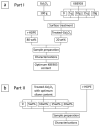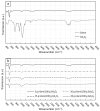Highly Efficient and Eco-Friendly Thermal-Neutron-Shielding Materials Based on Recycled High-Density Polyethylene and Gadolinium Oxide Composites
- PMID: 38675059
- PMCID: PMC11054564
- DOI: 10.3390/polym16081139
Highly Efficient and Eco-Friendly Thermal-Neutron-Shielding Materials Based on Recycled High-Density Polyethylene and Gadolinium Oxide Composites
Abstract
Due to the increasing demands for improved radiation safety and the growing concerns regarding the excessive use of plastics, this work aimed to develop effective and eco-friendly thermal-neutron-shielding materials based on recycled high-density polyethylene (r-HDPE) composites containing varying surface-treated gadolinium oxide (Gd2O3) contents (0, 5, 10, 15, and 20 wt%). The results indicate that the overall thermal-neutron-shielding properties of the r-HDPE composites were enhanced with the addition of Gd2O3, as evidenced by large reductions in I/I0, HVL, and TVL, as well as the substantial increases in ∑t and ∑t/ρ of the composites. Furthermore, the results reveal that the values for tensile properties initially increased up to 5-15 wt% of Gd2O3 and then gradually decreased at higher contents. In addition, the results show that the addition of Gd2O3 particles generally increased the density (ρ), the remaining ash at 600 °C, and the degree of crystallinity (%XC) of the composites. This work also determined the effects of gamma irradiation on relevant properties of the composites. The findings indicate that following gamma aging, the tensile modulus slightly increased, while the tensile strength, elongation at break, and hardness (Shore D) showed no significant (p < 0.05) differences, except for the sample containing 5 wt% of Gd2O3, which exhibited a noticeable reduction in elongation at break. Furthermore, by comparing the neutron-shielding and mechanical properties of the developed r-HDPE composites with common borated polyethylene (PE) containing 5 wt% and 15 wt% of boron, the results clearly indicate the superior shielding and tensile properties in the r-HDPE composites, implying the great potential of r-HDPE composites to replace virgin plastics as effective and more eco-friendly shielding materials.
Keywords: attenuation; gamma aging; mechanical properties; neutrons; rare-earth oxide; recycled materials.
Conflict of interest statement
The authors declare that they have no known competing financial interests or personal relationships that could appear to influence the work reported in this paper.
Figures












Similar articles
-
Dual X-ray- and Neutron-Shielding Properties of Gd2O3/NR Composites with Autonomous Self-Healing Capabilities.Polymers (Basel). 2022 Oct 22;14(21):4481. doi: 10.3390/polym14214481. Polymers (Basel). 2022. PMID: 36365475 Free PMC article.
-
Rare-Earth Oxides as Alternative High-Energy Photon Protective Fillers in HDPE Composites: Theoretical Aspects.Polymers (Basel). 2021 Jun 10;13(12):1930. doi: 10.3390/polym13121930. Polymers (Basel). 2021. PMID: 34200711 Free PMC article.
-
Ulexite/HDPE-Bi2O3/HDPE layered composites for neutron and gamma radiation shielding.Appl Radiat Isot. 2023 Oct;200:110940. doi: 10.1016/j.apradiso.2023.110940. Epub 2023 Jul 10. Appl Radiat Isot. 2023. PMID: 37453181
-
Simulation of Neutron/Self-Emitted Gamma Attenuation and Effects of Silane Surface Treatment on Mechanical and Wear Resistance Properties of Sm2O3/UHMWPE Composites.Polymers (Basel). 2021 Oct 2;13(19):3390. doi: 10.3390/polym13193390. Polymers (Basel). 2021. PMID: 34641205 Free PMC article.
-
Recent Progress in Gd-Containing Materials for Neutron Shielding Applications: A Review.Materials (Basel). 2023 Jun 10;16(12):4305. doi: 10.3390/ma16124305. Materials (Basel). 2023. PMID: 37374489 Free PMC article. Review.
References
-
- Kardjilov N., Manke I., Hilger A., Strobl M., Banhart J. Neutron imaging in materials science. Mater. Today. 2011;14:248–256. doi: 10.1016/S1369-7021(11)70139-0. - DOI
-
- Kardjilov N., Manke I., Woracek R., Hilger A., Banhart J. Advances in neutron imaging. Mater. Today. 2018;21:652–672. doi: 10.1016/j.mattod.2018.03.001. - DOI
-
- Ohta M., Kwon S., Sato S., Ochiai K., Suzuki H. Investigation of Mo-99 radioisotope production by d-Li neutron source. Nucl. Mater. Energy. 2018;15:261–266. doi: 10.1016/j.nme.2018.05.017. - DOI
-
- Meier W.R., Abbott R., Beach R., Blink J., Caird J., Erlandson A., Farmer J., Halsey W., Ladran T., Latkowski J., et al. Systems modeling for the Laser Fusion-Fission Energy (LIFE) power plant. Fusion Sci. Technol. 2009;56:647–651. doi: 10.13182/FST18-P2.32. - DOI
Grants and funding
LinkOut - more resources
Full Text Sources
Research Materials
Miscellaneous

